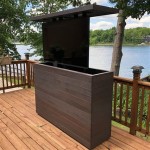How to Restrain Wood Cabinets Without Sanding: A Comprehensive Guide
If you're looking to refresh the look of your wood cabinets without the hassle of sanding, you're in luck. Restaining wood cabinets without sanding is a DIY project that can be completed in just a few steps and can dramatically improve the appearance of your kitchen or bathroom.
Before you start, it's important to gather the necessary materials. You will need:
- Wood cleaner
- Tack cloth
- Wood stain
- Rags or brushes
- Polyurethane finish
Once you have your materials, follow these steps to restain your wood cabinets without sanding:
Step 1: Clean the CabinetsStart by cleaning the cabinets with a wood cleaner. This will remove any dirt or grease that could prevent the stain from adhering properly.
Step 2: Apply Tack ClothOnce the cabinets are clean, wipe them down with a tack cloth to remove any remaining dust or debris.
Step 3: Apply Wood StainApply the wood stain to the cabinets using a rag or brush. Work in the direction of the wood grain and apply even strokes.
Step 4: Allow the Stain to DryAllow the stain to dry completely according to the manufacturer's instructions.
Step 5: Apply Polyurethane FinishOnce the stain is dry, apply a polyurethane finish to protect the stain and give the cabinets a glossy finish. Apply two or three coats of polyurethane, allowing each coat to dry completely before applying the next.
Tips for Success:- Test the stain on an inconspicuous area first to ensure that you are happy with the color.
- Use a high-quality wood stain and polyurethane finish for best results.
- Apply thin, even coats of stain and polyurethane.
- Allow ample time for drying between coats.
- Protect your work area with drop cloths or plastic sheeting.
Restaining wood cabinets without sanding is a relatively simple project that can be completed in a few hours. By following these steps, you can achieve a professional-looking finish that will refresh the look of your cabinets and enhance the overall appearance of your kitchen or bathroom.

Staining Your Wood Cabinets Darker Young House Love

How I Updated My Oak Cabinets Without Paint By Using Briwax Easy Budget Kitchen Makeover Only 24

How To Paint Kitchen Cabinets Without Sanding Or Priming

Refurbish Old Cabinets Without Sanding Using Gelstain

How To Paint Kitchen Cabinets Without Sanding Or Priming

How To Refinish Kitchen Cabinets Without Stripping Ron Hazelton

Gel Stain Kitchen Cabinets Without Sanding Fast Easy Diy

How To Remove Stain Without Sanding Confessions Of A Serial Do It Yourselfer

Darken Cabinets Without Stripping The Existing Finish Pneumatic Addict

How To Paint Kitchen Cabinets Without Sanding Sustain My Craft Habit
Related Posts








